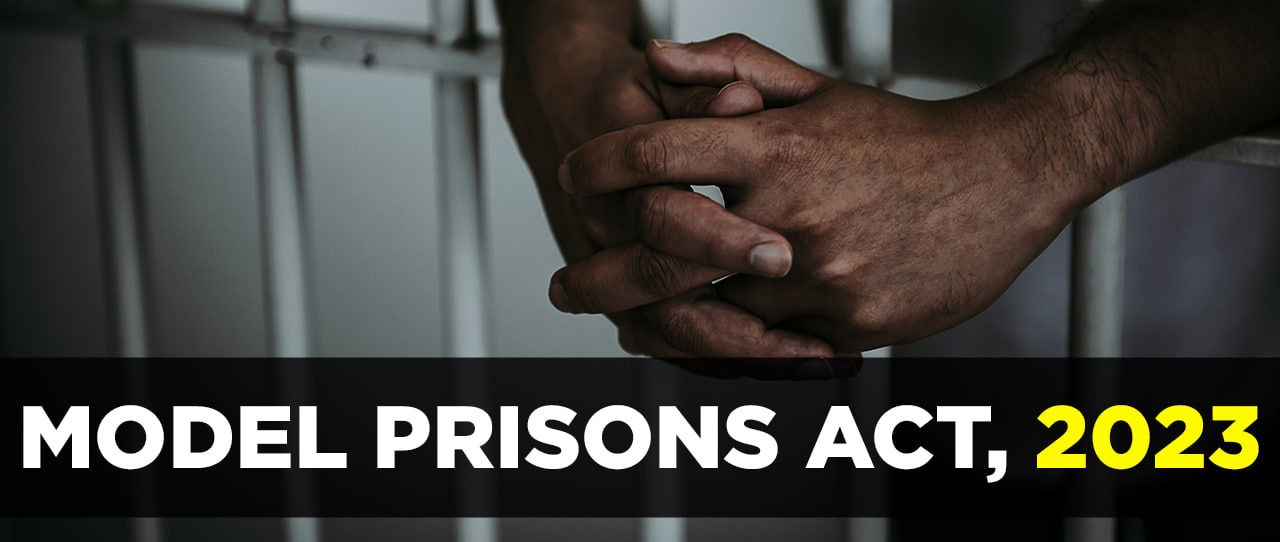
Copyright infringement not intended
Context: The Ministry of Home Affairs (MHA) announced that it has finalised the preparation of the Model Prisons Act, 2023, to replace the existing 130-year-old colonial law in an attempt to shift the focus of incarceration from “retributive deterrence” to “reform and rehabilitation”.
Details
- Currently, the Indian penal system is governed by the Prisons Act 1894, which was enacted during British colonial rule.
- The Act is outdated and does not reflect the changing needs and aspirations of a modern democratic society.
- It also does not conform to the international standards and norms of human rights and prison management.
- The Model Prisons Act 2023 aims to provide a comprehensive legal framework for the administration and management of prisons and correctional services in India. It also seeks to ensure the dignity, safety and welfare of prisoners and prison staff, as well as the protection of society from crime.
Some of the Features of the new proposed Model Prisons Act 2023
- It defines the rights and duties of prisoners and prison staff and provides for grievance redressal mechanisms and independent oversight bodies.
- It lays down the minimum standards of living conditions, health care, education, vocational training, work and wages, recreation and cultural activities for prisoners.
- It recognises the special needs and vulnerabilities of different categories of prisoners, such as women, children, elderly, differently abled, transgender, foreign nationals and undertrials.
- It promotes the use of alternatives to imprisonment, such as probation, parole, community service and restorative justice.
- It encourages the involvement of civil society organisations, volunteers and experts in the delivery of prison services and programmes.
- It mandates the collection and dissemination of data and research on prison matters for evidence-based policy-making and evaluation.

It may also face several challenges in its implementation. Some of them are:
Lack of political will
- Since prisons are a state subject in India, the adoption of the new act depends on the willingness of the state governments.
- However, many states may not show enough interest or commitment to implement the reforms due to a lack of funds, resources or political incentives.
Resistance from prison staff
- The new act may face resistance from some prison staff who may be reluctant to change their old ways of working or who may have vested interests in maintaining the status quo.
- There may also be a need for training and capacity building of prison staff to enable them to perform their duties effectively under the new act.
Infrastructure constraints
- Many Indian prisons are overcrowded, understaffed, poorly maintained and lack basic amenities such as healthcare, sanitation, ventilation, etc.
- The new act may require significant investment in upgrading the existing infrastructure or building new prisons to meet the standards prescribed by the act.
Social stigma
- The new act aims to rehabilitate and reintegrate prisoners into society by providing them with education, vocational training, counselling, etc.
- However, these efforts may be hampered by the social stigma and discrimination that ex-prisoners face from their families, employers and communities.
- There may also be a lack of support systems and opportunities for ex-prisoners to lead a dignified life after their release.
Some of the possible measures that can facilitate its successful implementation are:
Creating awareness
- There is a need to create awareness among the public, media, civil society and policymakers about the need and benefits of prison reforms.
- This can help generate public support and pressure for implementing the reforms and reducing the social stigma associated with prisoners.
Enhancing coordination
- There is a need to enhance coordination among various agencies involved in prison administration such as MHA, state governments, judiciary, police, NGOs, etc.
- This can help ensure the smooth functioning of prison operations and avoid duplication or conflict of roles.
Monitoring and evaluation
- There is a need to monitor and evaluate the progress and impact of prison reforms regularly. This can help identify the gaps and challenges in implementation and take corrective measures accordingly.
- It can also help assess the outcomes and effectiveness of various reformation programs on prisoners' behaviour and well-being.
Sharing best practices
- There is a need to share best practices and learnings from other countries or states that have successfully implemented prison reforms. This can help adopt innovative solutions and avoid common pitfalls in implementing prison reforms.

Conclusion
- The Model Prisons Act 2023 is expected to bring about a paradigm shift in the Indian penal system from punishment to correction. It is hoped that it will foster a culture of respect for human rights and dignity among prisoners and prison staff, and facilitate the reintegration of offenders into society as productive and law-abiding citizens.
Must Read Articles:
Model Prisons Act 2023: https://www.iasgyan.in/daily-current-affairs/model-prisons-act
|
PRACTICE QUESTION
Q. Prison reform involves improving the conditions, treatment, and rehabilitation of prisoners, as well as addressing the root causes and consequences of mass incarceration. Why is prison reform necessary and important? What are the main challenges and barriers to achieving it? And what are some of the best practices and recommendations for advancing it?
|
https://indianexpress.com/article/explained/explained-law/model-prisons-act-mha-8630225/




